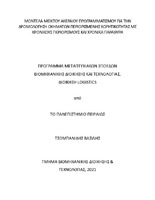Μοντέλα μεικτού ακέραιου προγραμματισμού για την δρομολόγηση οχημάτων περιορισμένης χωρητικότητας με χρονικούς περιορισμούς και χρονικά παράθυρα

View/
Abstract
Vehicle routing problems have been the focus of extensive research by the scientific community in recent decades driven by their economic importance and theoretical interest. A myriad of vehicle routing variations can be found in scientific literature emulating real-life distribution problems. The use of optimization techniques based on mathematical programming has been proven to reduce distribution cost up to 20% (Λάιος, 2010).
In this thesis a review of some of the most known vehicle routing problem variations is provided. In addition, we attempt to create two new vehicle routing models based on the vehicle routing models with time windows and the capacitated vehicle routing models we find in scientific literature. The new models receive additional information regarding the capabilities of the trucks that form the fleet. Furthermore, the models are enhanced with constraints that minimize truck usage and enforce a legal working schedule for the drivers.
Experiments are run on both models ensuring that they work as intended and exploring the maximum size of problems that the models are capable of solving. A comparison between the time efficiency of the cplex and gurobi optimizers is also made.


